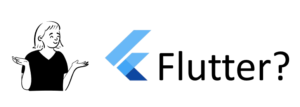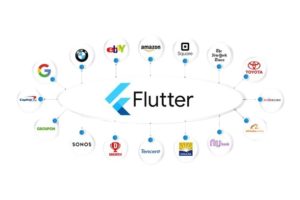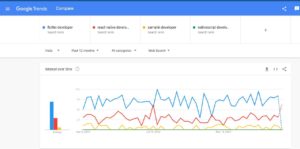Agentic AI Certification Training Course
- 125k Enrolled Learners
- Weekend/Weekday
- Live Class
Flutter is a revolutionary framework that empowers developers to create stunning and highly performant applications for multiple platforms, including mobile, web, and desktop, using a single codebase. With Flutter, you can build beautiful and engaging user interfaces, incorporate animations and special effects, and seamlessly integrate with backend services. Whether you’re a seasoned developer or just starting out, Flutter is a game-changer that makes it easier than ever to create high-quality applications that run on a wide range of devices. This blog post on “What is flutter” will cover the following topics:
Contents:
Why it’s worth discussing flutter?
What makes flutter unique from other frameworks?
Popular apps built with Flutter
Companies that use Flutter for their mobile development
Flutter is an open-source mobile development framework created by Google, designed to build high-performance, natively compiled applications for mobile, web, and desktop using a single codebase. It uses the Dart programming language, and its main focus is on delivering a fast, reactive, and modern user experience. Flutter’s unique feature is its ability to create beautiful, custom user interfaces through its extensive set of pre-built widgets, allowing developers to create visually appealing and engaging apps with ease.

Flutter is worth discussing because it is one of the most popular and rapidly growing mobile development frameworks available today. It has gained a lot of attention from developers due to its unique features, such as hot reload, which enables real-time updates without requiring the app to be restarted. Flutter’s cross-platform capabilities allow developers to write a single codebase that can be deployed on multiple platforms, including iOS, Android, web, and desktop, thereby reducing development time and costs. Additionally, It has a large and active community of developers who contribute to its growth, making it a promising choice for building modern and high-quality mobile applications.
Definition of Flutter
Flutter is a mobile app development framework that allows developers to create high-quality, visually appealing, and performant mobile applications for multiple platforms such as iOS, Android, web, and desktop using a single codebase.
It provides developers with an extensive range of customizable widgets and tools to build modern and responsive user interfaces. With its fast development cycle and hot reload feature, developers can make real-time updates and see the changes instantly without having to rebuild the entire app. Furthermore, Flutter’s cross-platform capabilities make it an efficient and cost-effective option for mobile app development.
Flutter is unique and different from other mobile development frameworks in several ways:

Single codebase: it uses a single codebase to develop mobile apps for multiple platforms, eliminating the need to write platform-specific code. This makes it an efficient and time-saving option for developers.
Fast development cycle: Flutter’s hot reload feature enables developers to see the changes they make to the code in real-time, without the need to rebuild the entire app. This results in faster development cycles and allows developers to make updates quickly and efficiently.
Customizable widgets: it provides a rich set of customizable widgets, making it easier for developers to create visually appealing and responsive user interfaces. This feature sets it apart from other mobile development frameworks.
Cross-platform compatibility: Flutter’s cross-platform compatibility allows developers to develop apps for iOS, Android, web, and desktop platforms using a single codebase. This makes it an attractive option for developers who want to create apps for multiple platforms while minimizing development time and costs.
Performance: it is known for its high performance due to its use of the Dart programming language and the Flutter engine. The engine uses Skia, a high-performance graphics engine, and compiles the Dart code to native machine code, resulting in fast and smooth app performance.
Here’s a comparison table of it with some of its popular competitor frameworks:
| Feature | Flutter | React Native | Xamarin | Ionic | NativeScript |
| Programming language | Dart | JavaScript | C# | HTML/CSS/JS | JavaScript/TypeScript |
| Single codebase | Yes | Yes | Yes | Yes | Yes |
| Hot reload | Yes | Yes | No | Yes | Yes |
| Native performance | Yes | No | Yes | No | Yes |
| Customizable widgets | Yes | Limited | Limited | Yes | Yes |
| Cross-platform | Yes | Yes | Yes | Yes | Yes |
| Learning curve | Moderate | Moderate | High | Low | Moderate |
| Community | Large | Large | Large | Large | Moderate |
| Development tools | Android Studio, Visual Studio Code | Visual Studio Code, Atom, IntelliJ IDEA | Visual Studio, Visual Studio for Mac | Visual Studio Code, Atom, Sublime Text | Visual Studio Code, WebStorm, IntelliJ IDEA |
Note that this table is not exhaustive and only includes some of the key features and differences between these frameworks. Ultimately, the choice of mobile development framework depends on the specific needs of the project, the development team’s skills and preferences, and other factors such as project budget and timeline.
Flutter has gained a lot of popularity in the mobile app development industry in recent years, and many popular apps have been built using this framework. Here are some examples of popular apps built with Flutter:
These are just a few examples of popular apps built with Flutter, but there are many more out there. The versatility and cross-platform capabilities of Flutter make it an attractive option for mobile app development.
Find out our Flutter Course in Top Cities
| India | Other Countries |
| Flutter Training in Chennai | Flutter Course in Australia |
| Flutter Course in Bangalore | Flutter Course in Canada |
| Flutter Training in Hyderabad | Flutter Course in London |
Flutter has gained significant traction in the mobile app development industry, and many companies have adopted it for their mobile development needs.

Here are some notable companies that use Flutter for their mobile app development:
The global developer occupants are about to reach 28.7 million people by 2024, an increase of 15.2 million from the number viewed in 2023

Flutter is a popular choice for building cross-platform mobile applications for both Android and iOS platforms. The demand for Flutter developers has increased since its launch due to its unique features and benefits.
As more businesses are adopting it for their mobile app development needs, the demand for Flutter developers is increasing. According to various job portals and industry reports, the demand for Flutter developers has increased significantly over the past few years, and this trend is expected to continue in the coming years.
In addition, the Flutter community is growing rapidly, which is also contributing to the demand for Flutter developers. The community provides a platform for developers to share knowledge, and best practices, and support each other, making it easier for businesses to find and hire skilled Flutter developers.
While Flutter is a powerful and versatile mobile app development framework, it does have some limitations. Some of the limitations of it include:
Limited access to native functionality: While it does provide access to a range of native features and functionality, it doesn’t provide the same level of access as native app development frameworks. This can limit the range of features and functionality that can be implemented in a Flutter app.
Large app size: Flutter apps tend to have larger file sizes than apps developed using other frameworks, which can be a concern for users with limited storage space on their devices.
Limited third-party library support: While it has a growing library of pre-built widgets and libraries, it may not have the same level of third-party library support as other mobile development frameworks.
In conclusion, Flutter is a powerful and versatile mobile app development framework that has gained popularity in recent years due to its speed, performance, and flexibility. With its hot reload feature, rich set of pre-built widgets and libraries, and robust testing and debugging tools, it has made it easier and faster for developers to build high-quality, visually appealing apps for both Android and iOS platforms.
Looking ahead, the future of it looks bright. Google continues to invest in the framework and is constantly adding new features and functionality to make it even more powerful and versatile. As more developers become familiar with Dart programming and the Flutter framework, we can expect to see a growing number of apps developed using Flutter.
Moreover, with the introduction of Flutter for desktop and web, it has the potential to become a popular choice for multi-platform app development. The ability to write code once and deploy it across multiple platforms could be a game-changer for app development, allowing developers to save time and resources while creating high-quality, feature-rich apps for a wide range of devices.
This brings us to the end of this blog on what is Flutter. Hope I was able to clearly explain what is Flutter and why you should use it.
If you want to get trained in Flutter and wish to develop interesting UI’s on your own, then check out the best Flutter Course offered by Edureka, Our Flutter Course Syllabus, curated by industry experts that will help you to master its all concepts.
Got a question for us? Please mention it in the comments section and we will get back to you.